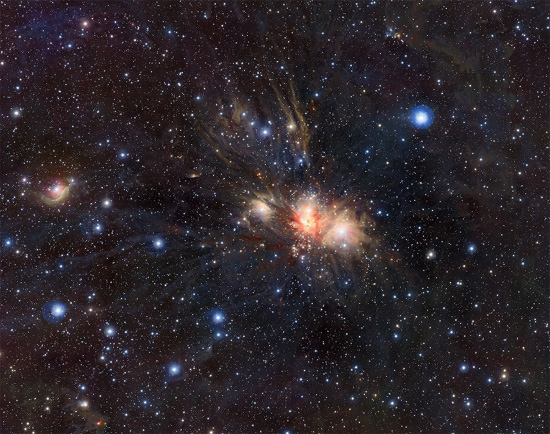
So-called “star-forming region” Monoceros R2 thought to be 2700 light-years from Earth.
Credit: ESO/J. Emerson/VISTA. Acknowledgment: Cambridge Astronomical Survey Unit.
Oct 30, 2013
Astrophysicists are hung up on gravity-only theories of star formation.
According to the standard model, new stars result from a compression wave passing through a cloud of dust and gas. Supernovae explosions from another part of the galaxy push nebulae into a star making process based on gravitational collapse. Electrical activity never enters the discussion. “Hot gas” is identified instead of “plasma.” Scientists will occasionally admit that the gas is plasma, but they mean “hot neutral gas” and not ionized matter. Nebular cloud analysis is based on kinetic models of gas behavior and not on plasma physics.
A more accurate model for nebulae is a fluorescent lamp emitting light at the excitation frequency of a specific gas. Electricity causes the plasma within the lamp housing to glow. According to astronomers, supernova shock waves are able to initiate many frequencies of light because the compressed gas is heated to high temperatures. However, since ionized oxygen frequencies make up more than 90% of the light from planetary nebulae they should be thought of as oxygen discharge tubes and not balls of hot gas.
The European Southern Observatory (ESO) believes that Monoceros R2 is a prolific stellar nursery, constantly bearing new stars, although the dusty environment makes it difficult to see most of them: “…the Visible and Infrared Survey Telescope for Astronomy…penetrates the dark curtain of cosmic dust and reveals in astonishing detail the folds, loops and filaments sculpted from the dusty interstellar matter by intense particle winds and the radiation emitted by hot young stars.”
The idea that gas can be heated until it gives off intense radiation (extreme ultraviolet and X-rays) without electrical input, or that a “wave” of ionized particles does not comprise an electric current betrays adherence to outmoded theories despite observational evidence.
An electromagnetic z-pinch can squeeze plasma with such force that it rapidly compresses. Electric current flowing into the z-pinch might then force the plasma to erupt in a discharge. When we look at nebulae we are seeing plasma formations behaving as the laws of electric discharges and circuits dictate.
The filamentary structure and the finger-like filaments that spiral through and away from the Monoceros nebula are Birkeland currents, named after Kristian Birkeland, who first proposed their existence in the late 1800s. Those currents form scalable tubes of plasma that can transmit electric power all around the galaxy.
No further study is required when one considers the Electric Star hypothesis. Rather than mechanical action (heated gas), Monoceros R2’s radiant emanations are due to electric currents powering its interior stars. Electrical sheaths (double layers) that are normally invisible receive greater input from the galactic Birkeland currents in which they are immersed, entering the “glow discharge” state. The increased flux density pulls matter from the surrounding space (and other stars) into filaments that ignite the nebular gasses electrically.
Stephen Smith
Click here for a Spanish translation












